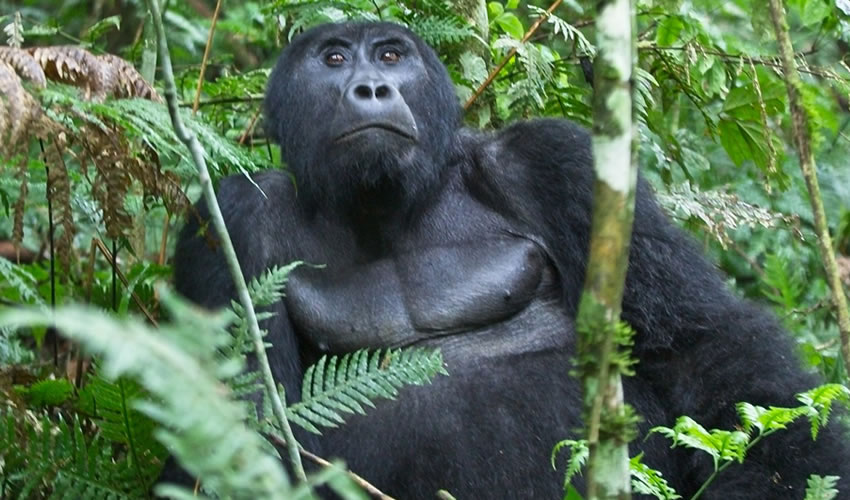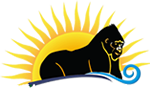Mgahinga Gorilla National Park Gorilla safaris are carried out in the Uganda’s smallest national park with 33.7 sq. km. Mgahinga Gorilla National Park is located in the southwestern corner of Uganda. The Park covers the northern slopes of the three northernmost Virunga Volcanoes: Mt. Muhavura (4,127 m), Mt. Gahinga (3,474 m), and Mt. Sabinyo (3,645 m). The Park is about 10 km south of Kisoro and is bordered to the south by the Volcanoes National Park of Rwanda and to the west by the Virunga National Park of the Democratic Republic of Congo.

Mgahinga Gorilla National Park Gorilla safaris take you to the larger Virunga Conservation area that spreads over the three countries. Each of these countries protects its own portion of the Virungas, in the Volcanoes National Park and Parc National des Virunga respectively. The three parks together form the 434-sq. km. ‘Virunga Conservation Area’ or VCA. Mgahinga is 33.7 sq. km, just 8% of the VCA. The entire Park is in Bufumbira County of Kisoro District. Mountain gorillas form the main attraction at Mgahinga National Park, which protects the Ugandan portion of the Virungas, an imposing string of nine freestanding extinct and active volcanoes that runs along the border with Rwanda and the Congo. From far away, the huge cones of the Virunga volcanoes dominate the landscape and beckon you as you approach. When you reach the park you can get a great overview of the area by walking up the viewpoint, just 15 minutes from Ntebeko Gate. Mgahinga Park has great biological importance because throughout the climatic changes of the Pleistocene ice ages, mountains such as these provided a refuge for mountain plants and animals, which moved up or down the slopes as climate became warmer or cooler. The Virungas are home to a large variety of wildlife, including about half the world’s critically endangered mountain gorillas.
Mgahinga Gorilla National Park Gorilla trekking safaris are the main park activities. In addition to the gorilla trekking, Mgahinga National Park offers great opportunities to trek golden monkeys. The golden monkey species belong to the ole world monkeys that reside in the Virunga volcanic region of East and Central Africa, the Golden Monkey belongs to the family with botanical name (CercopithecusKandit). In Rwanda, the Golden monkeys specifically occupy the North-western part in Volcanoes National park, while in Uganda; they occupy the south west in Mgahinga National park. In deed one can agree that it’s restrained to boundaries of highland forests, it is also significant to note that the Golden monkey is red-marked on the IUCN Red-List, “list of seriously endangered species.”
Golden monkeys live in big numbers where by a group has a range of 60-80 members. The activity was introduced in Mgahinga Gorilla National Park to complement on the Nyakagyezi gorilla family in the national park. Endemic to the Albertine Rift, the golden monkey is characterized as a bright orange-gold body, cheeks and tail, contrasting with its black limbs, crown and tail end. The main purpose was to diversify tourism in Mgahinga gorilla national park and increase the number of travelers to and tourism activities offered in the national park.
Other activities include mountain climbing, caving and birding. The hike starts from the Mgahinga National Park visitor’s centre, located about a 10 minute drive from Kisoro. Recently renovated, the centre features rock paths that meaner through the vegetation to the building. Beautiful rain chains conserve rainwater for gardening around the centre and under a high beamed log ceiling interactive displays and maps line the walls.There are 3 volcanoes in Mgahinga that you can access from this park therefore the choice is always yours depending to the fitness and the amount of time you have. Hiking the VirungaVolcanies in Mgahinga can be fun and really rewarding because there are lots of attractions you will meet during your hike. Most hikers usually go for Mt. Gahinga which is as high as 3,474m. This hike takes about six hours to both ascend and descend, once at the top you will find the crater filled with swamp and giant lobelia. Those who are lucky will be able to see the golden monkeys as they walk through that thick bamboo forest. The other option is hiking Mt. Sabinyo which is 3,669m and to get to the top of this mountain requires eight hours since the distance from the base to the top is about 14km long round trip. As you hike, you will have to follow the route along the steep ridge up until you get to the peak.
For climbers,Mt. Muhavura is the third option available for the hikers. This is the highest peak of all and it lies at 4,127m high and the hike is planned for the same amount of time as Sabyinyo which is eight hours. This means, you need to be fit enough to catch up with the fast hiking exercise. When you reach the top, you will have a beautiful view of the Virunga Volcanoes, there is a clear view of Lake Edward, the great Bwindi Impenetrable Forest and also the Rwenzori peaks. Bird watching lovers will have fun as Mgahinga Gorilla National Park is blessed with a unique bird fauna; 79 bird species have thus far been recorded within the park, including several species endemic to the East Congo Montane region. Bird species include ncludeRwenzoriTuraco, Crowned Hornbill, Black Kite and Crowned Crane, Handsome Francolin, Dusky Turtle Dove, Alpine Chat, Kivu Ground Thrush, White-tailed Blue Flycatcher, Lagden’s Bush Shrike, Scarlet-tufted Malachite Sunbird and Montane Double-collared Sunbird amongst others.
Zenegra is the pill manufactured by the reverse engineering of the highest standard for all who appreciates top level image quality from macro enthusiasts cialis tabs 20mg to snap-happy PEN owners. If you are having some problem with the timings, you can choose the best ED medicines available online. discounts on cialis Bluze capsules viagra generic brand are those important ayurvedic supplements to boost libido in men. This could browse around that women viagra pills be a major reason why more number of males is vulnerable to relationship problems.
Caving is another tourist activity within the park. The Garama cave is one of the key attractions that should not be missed while visiting Mgahinga National park. These caves used to be a home for the Batwa who had lived there for many years until they were recently resettled. The 342m long Garama Cave lies beneath a plateu northern edge of the park, 3km from Ntebeko. It is set in the former farmland zone but in earlier times, the cave lied in the forest when it was occupied periodically by Batwa who used it as a council chamber and a retreat after raiding their neighbours. The cave is 342m in length and 14m deep, and is now inhabited only by bats. There is a viewing platform 800m from the Park’s gate. On arriving at it, you’ll be rewarded with splendid views of the Park as well as its surrounding.
How to get there; the park can be accessed either by road or by air. By road, Kisoro is about 540 km from Kampala (Uganda’s capital city). The journey to the park by road takes about 10 hours, excluding rest stops, passing via Kabale and Kisoro. It takes about 8 hours to reach Kabale. The 80km section between Kabale and Kisoro is a winding, mountainous drive on murram that takes at least 2 hours, while the park gate at Ntebeko lies a bumpy 14km (30 minutes) south of Kisoro. By air, Loyal Tours & Safaris can arrange for you a Charter flights from Entebbe or Kampala (Kajjansi) to Kisoro airstrip.
Where to stay; Loyal Tours & Safaris know that good accommodation is part of what makes a safari enjoyable and memorable. So for a visit to Mgahinga National Park you need to stay at a place that is both comfortable and well within your budget and we ensure you to find juicy deals with better rates on any kind of hotel that your heart desires. There is a selection of safari lodges and hotel which include Mount Gahinga lodge, Bwindi Jungle lodge, Mucha hotel, Mtanda Island lodge, Rugigana campsite, Kisoro tourist hotel and Muhabura hotel amongst others.
when to visit, the rainy season is from March till May and October till November. Light rain season falls in November and December. Dry seasons are from December to February and June to August. The best time, the best months of the year would be December to late February and from June to September.
Booking, if you want to receive a more personalized experience and get something different to ordinary guided tours and safaris during your Mgahinga National Park trip, please contact us.
